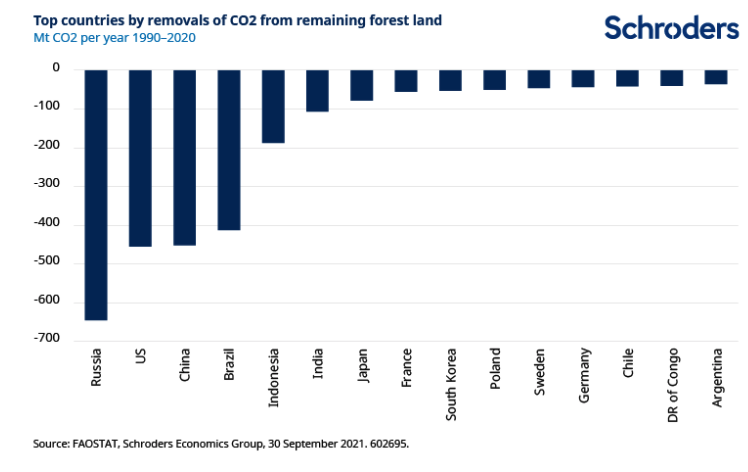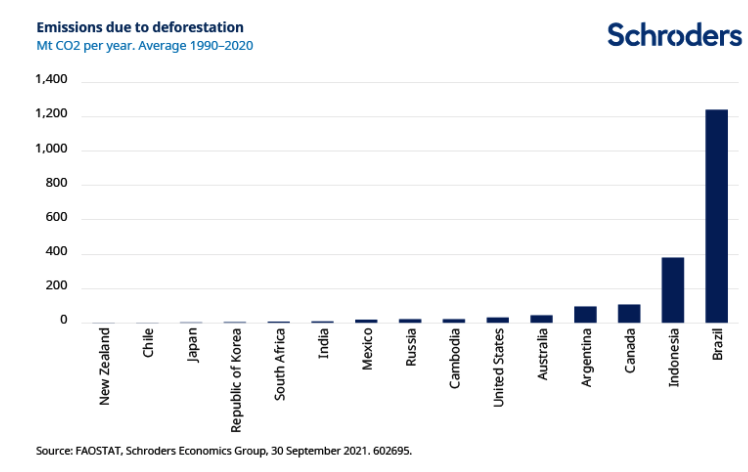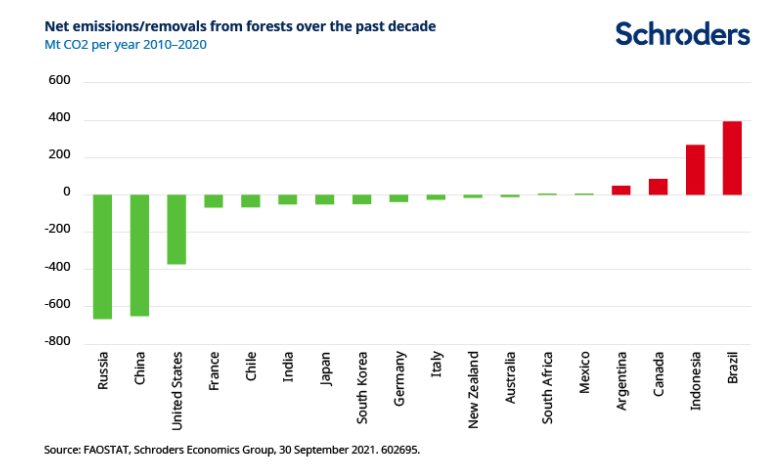
Beyond GDP growth: why natural capital matters

As the climate crisis accelerates, financial markets are paying more attention to risks and opportunities stemming from the energy transition, taking into consideration the risks related to fossil fuel production and consumption.
While decarbonising the production mix and promoting energy efficiency is essential to fight climate change, we think that markets are underestimating the fundamental role that the preservation of nature plays in the race to net zero.
Natural capital is a vital asset for the global economy. According to the World Economic Forum, more than half of global GDP depends on natural resources.
Nature plays an important role in enhancing human prosperity, as healthy ecosystems and biodiversity provide us with several fundamental benefits such as:
- provisioning services including food, water and timber
- regulating services that affect climate, floods, soil, disease, wastes, and water quality
- cultural services that provide recreational, aesthetic, and spiritual benefits.
A recent study estimates that total global ecosystem services provided benefits of US$125 trillion in 2011, that is more than one and a half times the size of global GDP (US$75tr).
Our economies are embedded within nature and the sustainability of economic development is strictly dependent on protecting natural ecosystems. But until now, economists, policy makers and financial markets have only focused on measures of economic performance, underestimating the costs of production at the expense of the environment.
The concept of natural capital has not, over centuries of commercial activity, been systematically included in decision-making or in economic indicators like GDP.
Countries have grown and developed over the centuries while eroding natural capital, but this has not been taken into account in any metric of economic performance.
GDP ignores natural capital and does not include the harm done to the environment through activity. But to achieve a more sustainable future, economic growth should increase without harming the environment.
The financial sector, as an intersection for capital allocation, should play a key role in supporting sustainability. Financial institutions could help build environmental resilience by decarbonising their portfolios and redirecting investments in solutions to tackle climate change and should therefore include the economics of biodiversity into transactions, as highlighted in the Dasgupta Review (2021).
This means that it will be important to judge economic performance through the lens of natural capital, as moving beyond GDP growth is essential to ensure a more sustainable development given the strong link between climate change and the environment. In this paper we take a step in this direction, focusing on forests’ ecosystems, the largest terrestrial carbon sink, and a major nature-based solution to the climate emergency.
The important benefits of forests
Forests provide many ecosystem services, such as carbon storage, erosion prevention, pollution control, biodiversity habitat and water purification. Yet, the precious value of these benefits has yet to be incorporated into financial transactions.
Here are a few examples to highlight what we are missing in our current metrics. According to the US Department of Agriculture, national forests are the single most important source of water in the US, supplying drinking water for 180 million Americans in 68,000 communities.
Mangrove forests reduce annual flooding to people globally by more than 39%, providing benefits to more than 18 million people every year, with Vietnam, India, Bangladesh, China, and the Philippines receiving the greatest benefits. Mangroves reduce annual property damages by more than 16%, with an annual value of more than US$ 82 billion (source: The global value of mangroves for risk reduction. Technical Report. The Nature Conservancy, Berlin, 2018.
Even more importantly for our climate emergency, a recent study shows that actions aimed at increasing carbon sequestration through conservation, restoration, and improved management practices in forest, wetland, and grassland biomes (so-called natural climate solutions, NCS), can provide up to 37% of the emission reductions needed by 2030 to keep global temperature increases under 2°C.
Discover more by visiting Schroders’ insights or click the links below:
– Read: COP26: a quick guide to common climate terms
– Listen: Podcast: Good COP, bad COP
– Watch: The company using education to help save lives in India
Carbon sink vs carbon sources
Given the fundamental role that forests have in fighting a pressing problem such as global warming, it is important to understand which countries are the largest carbon sinks. And more importantly from an investor perspective, which are the countries that are growing while protecting, rather than depleting, their forests.
Forests cover around 30% of the world land area. Data from the Food and Agriculture Organization (FAO) show that remaining forest land, i.e., the area not being deforested, acted globally as a significant carbon sink over the past decades. In 2020 forests absorbed 2.6 gigatons of CO2, one-third of the CO2 released from burning fossil fuels.
Where are these precious carbon sinks? The chart below shows that over the past 30 years Russia, the US and China have been the largest carbon sinks, with their forests absorbing 636, 454 and 448 metric tons of CO2 per year, respectively.

However, since 1990 the world has lost more than 400 million hectares of forest through conversion to other land uses. As a result, the amount of emissions that forests can absorb has been reduced by a quarter during the past three decades due to large deforestation.
When forests are cleared or burnt, stored carbon is released into the atmosphere, mainly as carbon dioxide, with deforestation becoming the second largest anthropogenic source of carbon dioxide to the atmosphere, after fossil fuel combustion.
Carbon emissions from deforestation and forest degradation have been estimated to account for about 20% of global anthropogenic CO2 emissions.
Deforestation fluxes to the atmosphere were pretty significant during 1990-2020, averaging 3.7 Gt CO2 per year, with Brazil being the country with the highest estimated emissions from deforestation (1.2 Gt CO2 per year).
The chart below shows that Indonesia is also another country whose economic growth has been associated with environmental degradation, with its forests emitting 380 Mt CO2 per year over the past 30 years (the same amount that the UK emits annually from the combustion of coal, natural gas, oil, and other fuels, including industrial waste and non-renewable municipal waste).
Some developed countries like Canada, Australia, and the US have grown while depleting their forests.

Due to large deforestation, some forests have been transformed into a net emitter of carbon dioxide, rather than a sink absorbing the greenhouse gas. The chart below highlights that over the past 10 years, forests in Brazil, Indonesia, Canada and Argentina are releasing more carbon into the atmosphere than they are storing, contributing to an acceleration of the climate change crisis.

What is causing deforestation and why does it matter to investors?
Deforestation is largely driven by expanding agriculture. A recent study indicates that between 2010 and 2014, 60% of tropical forest loss was due to deforestation through land use change for cattle meat and oilseeds production. In particular, the expansion of pasture land to raise cattle was responsible for more than 2.1 million hectares every year – about half the size of the Netherlands.
In addition, the study shows that an important share of these emissions is attributed to commodities consumed internationally. Almost 40% of emissions embodied in production were attributed to exports. This is much higher than the share of fossil fuel emissions embodied in traded goods (23–26%). In addition, the study indicates that deforestation emissions embodied in imports amount to 17–31% of national agricultural emissions, but they are not yet considered in countries’ emissions accounts.
Investors are likely to be impacted by changing regulations
Why do we think that investors should pay attention to deforestation and its key drivers? Risks and opportunities stemming from the climate change fight are high on investors’ agenda. The Intergovernmental Panel on Climate Change (IPCC) suggests that global mitigation goals cannot be met without the inclusion of forests. Tackling land degradation and restoring forests ecosystems is therefore key to reducing GHG emissions, an urgent priority to fight global warming.
Financial institutions could therefore soon start to be exposed to transition risks that will arise from policies aimed at protecting the natural environment and reducing the depletion of natural resources. Investors could soon start to factor in the risks arising from lending to or investing in companies linked to unsustainable production of commodities involved in deforestation.
Finally, new investment opportunities will also arise from helping countries and companies achieve a more sustainable growth. The WEF has recently noted that transitioning three major sectors of the economy (food, land and ocean use, extractives and energy, and infrastructure) onto “nature-positive” paths could create US$10 trillion of economic growth and 395 million jobs by 2030. The total annual investment necessary to capture all the opportunities across the three sectors is estimated at about $2.7 trillion.
Integrating natural capital into our transactions will be a fundamental pillar in our move towards a more sustainable economy.
In our race to net zero, companies should start to incorporate the impact that their business has on the natural environment.
From an investor perspective, the past years have seen record levels of engagement in sustainability-related issues, and more action will be taken to fully understand the risks around the depletion of natural capital.
– For more visit Schroders insights and follow Schroders on twitter.
Topics:
Important Information: This communication is marketing material. The views and opinions contained herein are those of the author(s) on this page, and may not necessarily represent views expressed or reflected in other Schroders communications, strategies or funds. This material is intended to be for information purposes only and is not intended as promotional material in any respect. The material is not intended as an offer or solicitation for the purchase or sale of any financial instrument. It is not intended to provide and should not be relied on for accounting, legal or tax advice, or investment recommendations. Reliance should not be placed on the views and information in this document when taking individual investment and/or strategic decisions. Past performance is not a reliable indicator of future results. The value of an investment can go down as well as up and is not guaranteed. All investments involve risks including the risk of possible loss of principal. Information herein is believed to be reliable but Schroders does not warrant its completeness or accuracy. Some information quoted was obtained from external sources we consider to be reliable. No responsibility can be accepted for errors of fact obtained from third parties, and this data may change with market conditions. This does not exclude any duty or liability that Schroders has to its customers under any regulatory system. Regions/ sectors shown for illustrative purposes only and should not be viewed as a recommendation to buy/sell. The opinions in this material include some forecasted views. We believe we are basing our expectations and beliefs on reasonable assumptions within the bounds of what we currently know. However, there is no guarantee than any forecasts or opinions will be realised. These views and opinions may change. To the extent that you are in North America, this content is issued by Schroder Investment Management North America Inc., an indirect wholly owned subsidiary of Schroders plc and SEC registered adviser providing asset management products and services to clients in the US and Canada. For all other users, this content is issued by Schroder Investment Management Limited, 1 London Wall Place, London EC2Y 5AU. Registered No. 1893220 England. Authorised and regulated by the Financial Conduct Authority.
